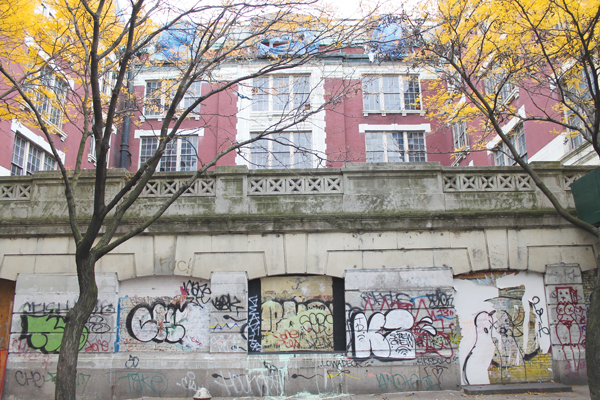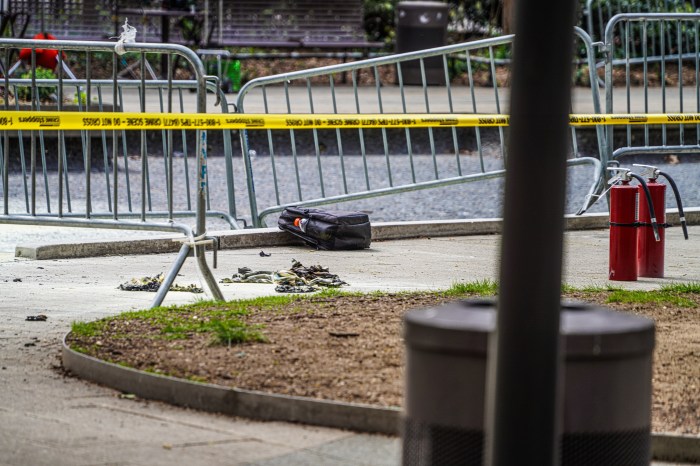
BY LINCOLN ANDERSON | Although all is quiet on the old P.S. 64 front, developer Gregg Singer assured The Villager that the vacant, landmarked building will soon enough be transformed into an in-demand, state-of-the-art student dormitory.
“Just waiting for approvals,” he said calmly in a recent, rare phone interview. “You know — it just takes time.”
Singer purchased the former city-owned building at auction for a mere $3.2 million in 1998, but his plans to develop the property with a high-rise dormitory tower were shot down by the city, and ultimately defeated when the Bloomberg administration landmarked the building in 2006.
Until the end of 2001, the address was home to CHARAS / El Bohio Cultural and Community Center. A group of local Puerto Rican activists, CHARAS had cleared the run-down eyesore of junkies and hookers and transformed the place into a neighborhood activist and arts hub.
This April, the determined developer pitched a downscaled dorm plan to house up to 530 students in the existing, “H”-style, turn-of-the century school building. It would house students from The Cooper Union and Joffrey Ballet School, he said.
But in May, more than 150 community activists, joined by local politicians and CHARAS Executive Director Chino Garcia, marched from the old school building, at 605 E. Ninth St., to Cooper Union’s Foundation Building to warn Cooper, “Don’t get in bed with Singer!”
At the time, the developer’s workers were busy gutting the building for its upcoming makeover into a high-tech dorm. But more recently, the work suddenly stopped. However, Singer maintained all is going right according to plan.
“We’ve completed all interior demolition, and we’re waiting for approvals to renovate the building,” he said last week. “Now it’s all just open [inside], and it’s ready for the construction. We’re just waiting for permits.”
The interior construction should start “sometime in 2014,” he said. He expects that by August 2015, the new dorm will be ready for occupancy for that upcoming school year.
So far, Singer said, four floors of the six-story building (counting the basement) are spoken for. Joffrey Ballet is slated to get the basement level and ground floor, and Cooper the second and third floors. The basement level will also have a game room, health center, fitness center and theater.
The plan is to open up the E. 10th St. street wall by adding windows, which “will add life to the street,” he said.
He’s still looking for a school to lease out the top two floors. Asked if the dorm would take random university students from various schools, he said, no, the tenant or tenants for these floors “would have to be affiliated with an institution.”
He was confident he’ll be able to fill the building.
“We did a study,” he said. “There is a 57,000-bed shortage for students. New York has 112 colleges.”
He said that — although he doesn’t need to do this — he will be restoring the building’s exterior details that he had lopped off in a failed effort to overturn the building’s landmarking seven years ago. (At the time, one of his lawyers bluntly stated they were “scalping” the building.) The new facsimiles will be made of glass-fiber reinforced concrete, or G.F.R.C.
Singer still thinks his modified tower plan for the site — the second, slightly shorter version, a 19-story dorm that would have preserved the old school’s front — was a great idea.
“The tower — it was really a clever idea,” he reflected. “It was set back from the street. It was the same height as the Christadora House, and it was going to give the community $2 million.”
Singer’s scheme called for a nonprofit to own the dorm, and for $2 million of the facility’s annual profit to be funneled to local nonprofit groups.
In fact, he said, he only chopped off the old school’s exterior ornaments “to keep the ability to go up” and “preserve the cash flow for the community,” adding, “The city gave the permit to do that work.
“But they didn’t want it, so…,” he said of the defeated dorm tower scheme.
“If you’re not building up, you might as well put them back,” he said of the facade details.
The current cost of fixing up the building for the new dorm is around $40 million, he said.
“Yeah, terrible condition,” he noted of the former CHARAS’s state. “It’s a full, gut renovation.”
Asked if there would be any community facility inside, or if the community would be able to hold meetings there, he answered, “It’s a college dormitory. No, it doesn’t make any sense. … We tried that for years. We tried to do it that way, to do space for the community, space for their meetings. The councilmember didn’t want it,” he said, referring to Rosie Mendez.
Like the neighborhood activists who have fought Singer’s plans for 15 years, Mendez supports turning the facility back into a community center.
Susan Howard was part of the group arrested at CHARAS on the frosty-cold morning of Dec. 27, 2001. One hundred, helmet-wearing riot police had massed on E. Ninth St., ready to carry out an eviction of the activists. Any potential demonstration was nipped in the bud as the police quickly swooped in and arrested the activists, whose arms were chained together inside PVC tubes.
“Giuliani did not, on his last day in office, want a protest,” she said.
Howard, now a leader of the group SOCCC64 (Save Our Community Center CHARAS 64), said she looked at photos of the gutted space on the Massey Knakal real estate brokerage Web site and fears that Singer has cleared out the interior so aggressively that the whole building could well collapse. In fact, she believes that’s exactly his intent.
“He’s removed all the interior walls,” she said. “There are just some thin beams there now. I can’t tell if they’re existing support beams or ones he’s installed.”
Singer didn’t respond to follow-up calls about whether he is, in fact, trying to demolish the building under the guise of renovating it.
Howard accused the developer of still harboring his dream of erecting a towering dorm on the site. But what about the East Village / Lower East Side rezoning that caps building heights on side streets at around eight stories? she was asked. She countered that Singer could always go to the Board of Standards and Appeals for a waiver.
“How long should the building sit there unused?” she said. “If he can’t develop it, he should just return the building to the community.”

















